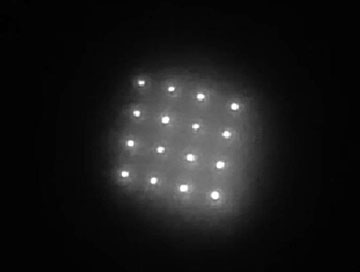![]()
SEM image of a dissolvable microneedle array [Credit: K.J. McHugh et al., Sci. Transl. Med. (2019)]
Poor medical recordkeeping in some regions of the developing world can contribute to preventable deaths due to undervaccination. As a possible solution to this pressing issue, a team of researchers from the Massachusetts Institute of Technology (MIT) has developed a new approach to track an individual’s vaccination history with fluorescent quantum dots embedded in the skin (Sci. Transl. Med., doi: 10.1126/scitranslmed.aay7162).
With such a system, medical professionals could in principle deliver a vaccine while simultaneously creating a permanent record of the vaccination.
Benefits of vaccination history
The World Health Organization estimates that 2 to 3 million deaths are prevented each year through immunization. Effective vaccines currently exist for infectious diseases such as diphtheria, hepatitis B, and polio—yet annually, 1.5 million vaccine-preventable deaths still occur worldwide. Regions that lack proper healthcare infrastructure and reliable medical records leave medical professionals unable to make informed decisions about administering vaccines.
“More data is needed to eradicate vaccine-preventable diseases such as polio and measles, and one component is to look at the issues around not knowing whether someone needs or does not need a shot,” said Ana Jaklenec, the new study’s corresponding author. “For example, when you received a shot for smallpox, you ended up getting a scar. That was an easy way to follow who was vaccinated or not during outbreaks.”

The quantum dots after being administered to the skin of rodents. [Credit: K.J. McHugh et al., Science Translational Medicine (2019)]
QR code of quantum dots
Some technologically advanced methods for recording vaccination history have been proposed as a replacement for the paper vaccination cards or certificates often found in developing countries. However, none have gained widespread adoption. Jaklenec and her colleagues propose an easy-to-use, robust and inexpensive alternative that encodes information directly into the skin with a pattern of near-infrared fluorescent quantum dots invisible to the naked eye.
The quantum dots are distributed through a dissolvable microneedle patch in a distinct spatial pattern, similar to a QR code, which contains information about the vaccine being delivered. The patch is applied to the skin for 2 to 5 minutes, and after the microneedles dissolve, the quantum dots remain embedded in a permanent layer of the skin. In order to read the information, a medical professional would only need a near-infrared LED to excite the quantum dots and a smartphone camera adapted with near-infrared filters.
Promising early results
The researchers extensively tested their system, first with ex vivo pig skin and human skin from cadavers. Then, they inserted simple patterns of quantum dots—a circle, a cross and a rectangle—into the skin of living rats to test their longevity. The patterns remained robust over the entire nine months of the experiment. Lastly, animals who received the poliovirus vaccine simultaneously with quantum dots showed no negative effect compared to those who received the vaccine alone.
“The next step is to qualify the dye with the Food and Drug Administration, and in parallel, we’re looking at the acceptability of such a system in different countries like Kenya and Malawi,” said Jaklenec. “We’re also working on encoding more information, like in a QR-code-type or bar-code-type pattern.”
In addition to researchers at MIT, the team also included scientists from the Chinese Academy of Sciences, China, Intellectual Ventures Laboratory, USA, and Institute for Disease Modeling, USA.
